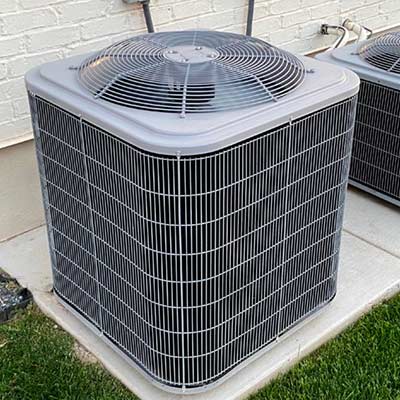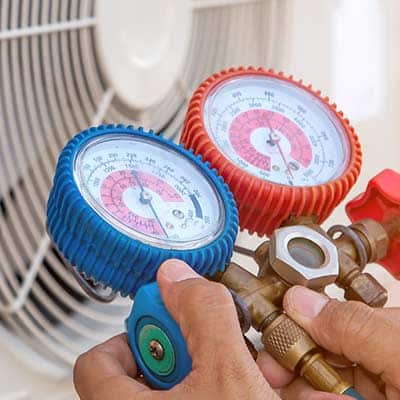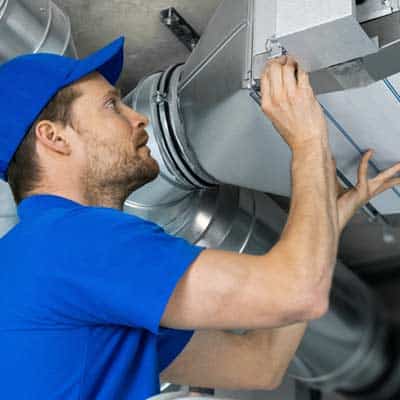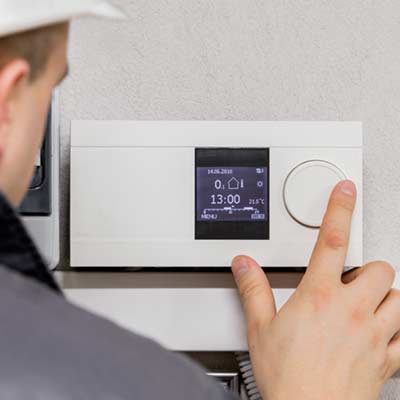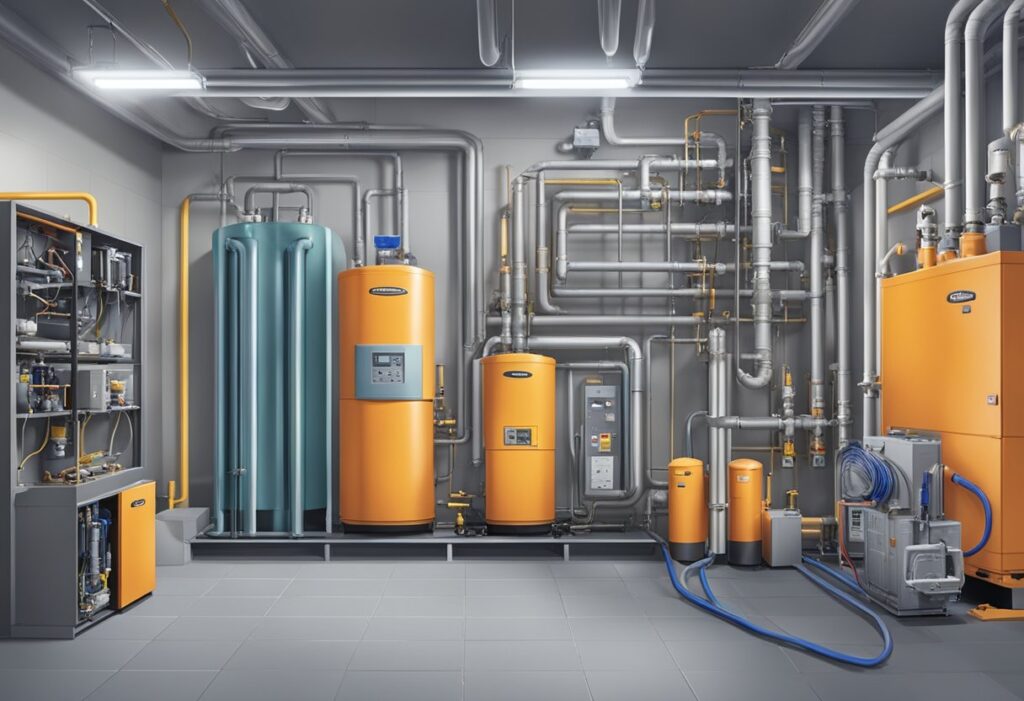
Understanding Geothermal HVAC Systems
In this article, we’re going to examine the inner workings of geothermal HVAC systems, focusing on their essential components and the principles guiding heat exchange.
Components of Geothermal Systems
The foundation of any geothermal HVAC system consists of three main elements:
- Geothermal Heat Pump: This is the heart of the system that moves heat between the building and the ground.
- Ground Heat Exchanger: A network of pipes, typically made from high-density polyethylene, buried in the soil or submerged in water.
- Distribution System: Consists of ductwork or radiant heat systems that distribute the conditioned air or water throughout the premises.
These components work in unison to harness geothermal energy. The geothermal heat pump transfers heat to or from the ground, depending on the climate needs.
Principles of Heat Exchange
The basic principle of heat exchange in a geothermal HVAC system is based on the thermodynamic properties of heat transfer. The two core processes involve:
- Heat Absorption: During cooler months, the system absorbs the earth’s natural warmth. The soil or water serves as a heat source, and the heat pump elevates the temperature for indoor heating.
- Heat Dissipation: In warmer periods, the system rejects building heat into the cooler earth. This process utilizes the soil or water body’s lower temperature to absorb heat from the indoor air.
The heat exchanger – a series of pipes laid horizontally or vertically in the ground – is a critical interface where the actual heat exchange occurs between the soil or rock and the anti-freeze liquid circulating within the pipes.
By leveraging the relatively stable underground temperatures, remarkably efficient ground-source heat pumps, making geothermal systems both a sustainable and cost-effective choice for temperature regulation. Our understanding of these systems allows us to appreciate their capacity for providing consistent indoor comfort while minimizing environmental impact.
Advantages of Geothermal HVAC Solutions
Geothermal HVAC systems harness stable underground temperatures to heat and cool homes more efficiently than traditional methods. These systems contribute to significant energy savings, reduced carbon emissions, and increased reliability.
Energy Efficiency and Savings
- Lower Energy Bills: Geothermal systems are up to 400% efficient, translating to substantial reduction in energy bills.
- Renewable Energy Utilization: They use renewable energy from the earth, which is both abundant and constant, leading to consistent temperature control with low operating costs.
Environmental Benefits
- Reduced Greenhouse Gas Emissions: By utilizing the earth’s natural heat, these systems have a lower carbon footprint than conventional HVAC systems.
- Eco-Friendly: Geothermal systems do not involve combustion, therefore they emit no carbon dioxide, carbon monoxide, or other greenhouse gases.
System Longevity and Reliability
- Durable Components: The indoor components of a geothermal system can last up to 25 years, while the ground loop has a lifespan of over 50 years.
- Consistent Operation: They provide reliability with their ability to maintain consistent indoor temperatures, year-round, without the extreme fluctuation seen in traditional HVAC systems.
Installation and Maintenance Considerations
In this section, we will explore the specific loop systems utilized in geothermal HVAC systems and the financial implications of installing and maintaining these systems.
Types of Loop Systems
We can choose between closed-loop and open-loop systems for our geothermal HVAC installation. Closed-loop systems circulate an antifreeze solution through pipes buried underground or submerged in a water source. They can be further categorized into ground loops which are horizontal or vertical, and pond/lake loops if the pipes are placed in a water body.
- Horizontal ground loops require extensive land area and entail trenches at least four feet deep.
- Vertical ground loops are suitable for smaller plots of land, drilling deep holes that can range from 100 to 400 feet per ton of capacity.
- Pond/lake loops are a cost-effective option if a suitable water body is nearby, with coils of pipe placed at least eight feet under water to prevent freezing.
Open-loop systems, on the other hand, use existing groundwater from a well as a heat exchange fluid, which is later returned to the ground through recharge wells or surface discharge.
Proper installation of loop systems, whether open or closed, mandates the expertise of qualified contractors with specialized training. We must ensure that these contractors follow all local building codes, environmental regulations, and manufacturer guidelines.
Upfront and Operating Costs
The costs associated with geothermal HVAC systems are an essential consideration. Installation costs can vary widely based on the type of loop system chosen, local geology, land availability, and regional labor rates.
- Upfront costs:
- Horizontal ground loops: typically the least expensive, but they require more land.
- Vertical ground loops: higher upfront cost due to the drilling required, but they consume less land.
- Pond/lake loops: can offer savings if a suitable water body is available.
- Operating costs: tend to be lower compared to traditional HVAC systems due to the high efficiency of geothermal technology. Maintenance requirements are minimal, usually involving periodic checks of the pump and heat exchange components to ensure optimal performance.
Part of our operating savings is due to the consistent ground temperatures, which enable the geothermal HVAC system to maintain efficiency over its lifetime, commonly 25 years for the indoor unit and 50+ years for the loop system. Regular maintenance by trained technicians is key to sustaining these efficiencies and protecting our investment.
Challenging Myths About Geothermal HVAC
Geothermal HVAC systems are often misunderstood, with many myths surrounding their cost and environmental impact. We’re here to address these misconceptions with facts, providing clarity on the true nature of geothermal HVAC technologies.
Cost Misconceptions
High Upfront Cost is one of the most prevalent myths. It’s true that geothermal HVAC installation involves a significant initial investment. However, looking at the whole picture reveals a different story.
- Long-Term Investment: We must consider geothermal systems as long-term investments. Over time, they can offer substantial savings on energy bills due to their high efficiency.
- Incentives and Tax Breaks: Various incentives such as tax credits can significantly lower the upfront costs. For instance, the U.S. federal government offers a Renewable Energy Tax Credit for geothermal installations.
Environmental Misconceptions
The myth that geothermal HVAC systems are not as environmentally friendly as claimed is unfounded.
- Reduced Temperature Differential: Geothermal systems leverage the consistent underground temperature to heat and cool buildings, which is a highly efficient process with minimal environmental disruption.
- Environmentally-Friendly: The use of geothermal energy dramatically reduces greenhouse gas emissions compared to conventional HVAC systems. We’re tapping into a clean, renewable source that’s always available, rain or shine.
Frequently Asked Questions
In this section, we address some common inquiries about geothermal heating, ventilation, and air conditioning (HVAC) systems to help you understand how they function and what considerations are necessary for their installation and maintenance.
How does a geothermal HVAC system work for home heating and cooling?
A geothermal HVAC system harnesses underground temperatures to heat and cool a home. In the winter, heat is extracted from the earth through a loop system and transferred indoors. During the summer, the process reverses, removing heat from the home and dispersing it into the ground.
Can a propane furnace be integrated with a geothermal heat pump?
Yes, a propane furnace can be integrated with a geothermal heat pump to create a dual-source heating system. This combination can provide higher efficiency and reliability, utilizing the geothermal pump primarily and switching to propane during extreme cold.
What are the basics one should know about geothermal heat pumps?
Geothermal heat pumps are energy-efficient systems that use the consistent underground temperature to provide heating and cooling. They consist of an indoor handling unit and a buried system of pipes, known as a loop, and are known for their longevity and low operational costs.
To what depth must a geothermal system be installed for effective heating?
The depth for a geothermal system typically ranges from 10 to 300 feet below ground. The precise depth is determined by local soil conditions, loop configuration, and energy needs. Professional assessment ensures that the system is installed at a depth that optimizes performance.
What are the typical lifespans of residential geothermal HVAC systems?
Residential geothermal HVAC systems typically last about 25 years for the indoor components and up to 50 years for the ground loop. This extended lifespan, when compared to conventional HVAC systems, underscores their durability and cost-effectiveness over time.
What are the main disadvantages of installing a geothermal loop system?
The main disadvantages include high upfront costs, the requirement for a significant amount of land to install the loop system, and potential compatibility issues with existing ductwork. It’s crucial to consider these factors alongside the long-term benefits and savings before installation.
